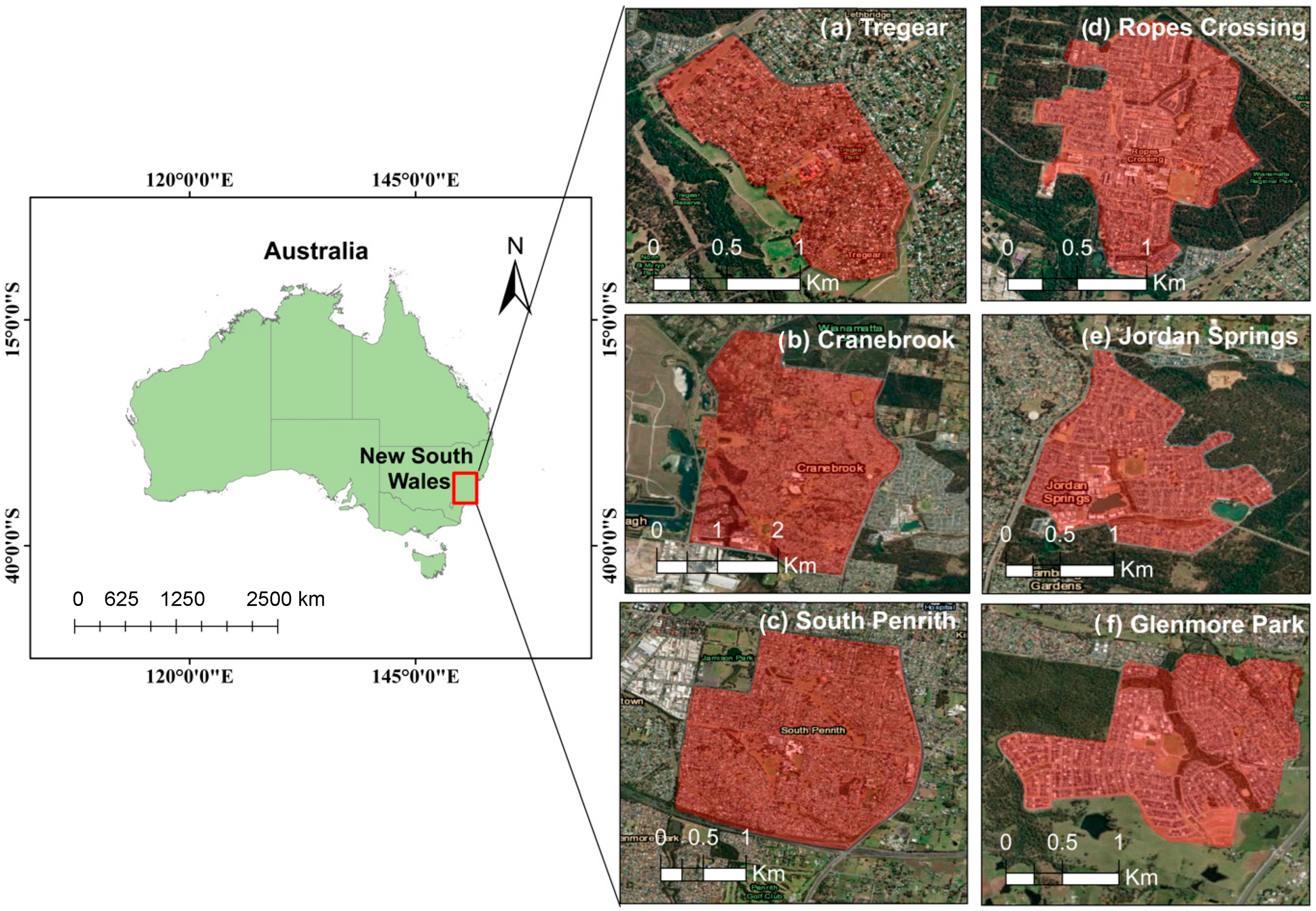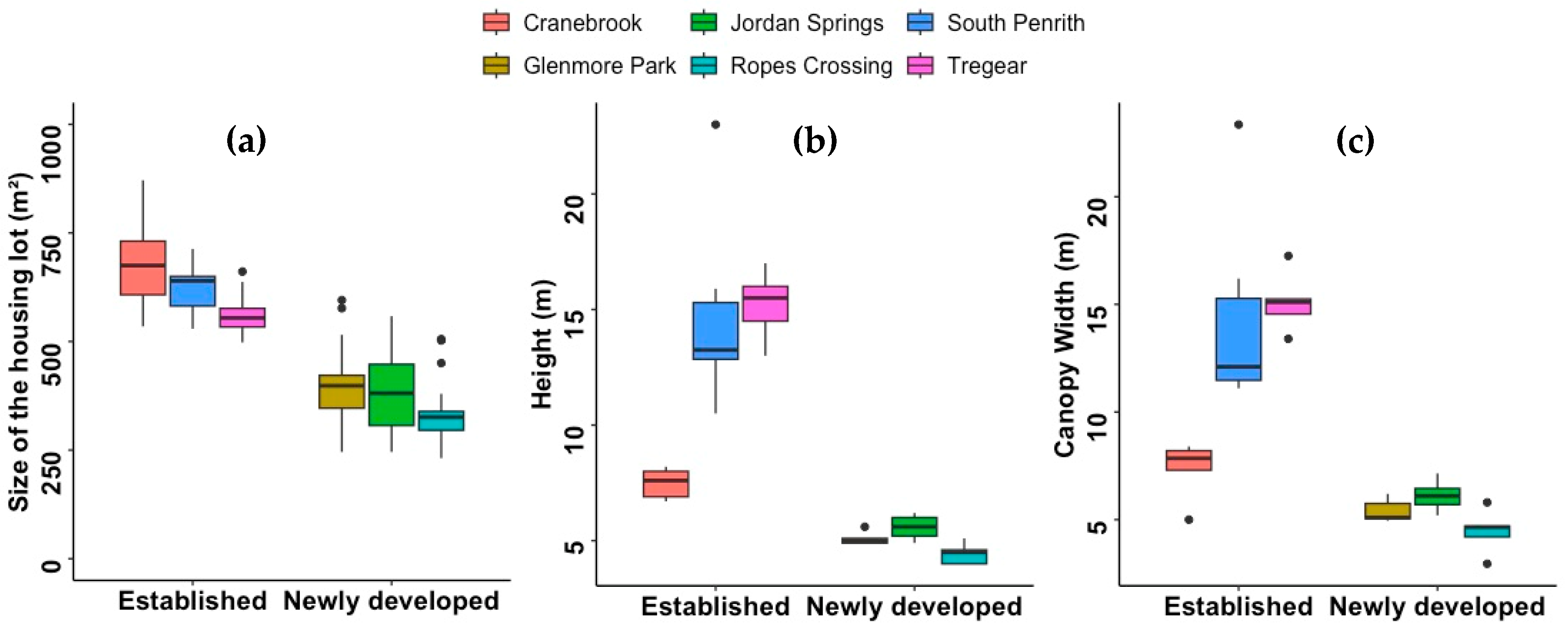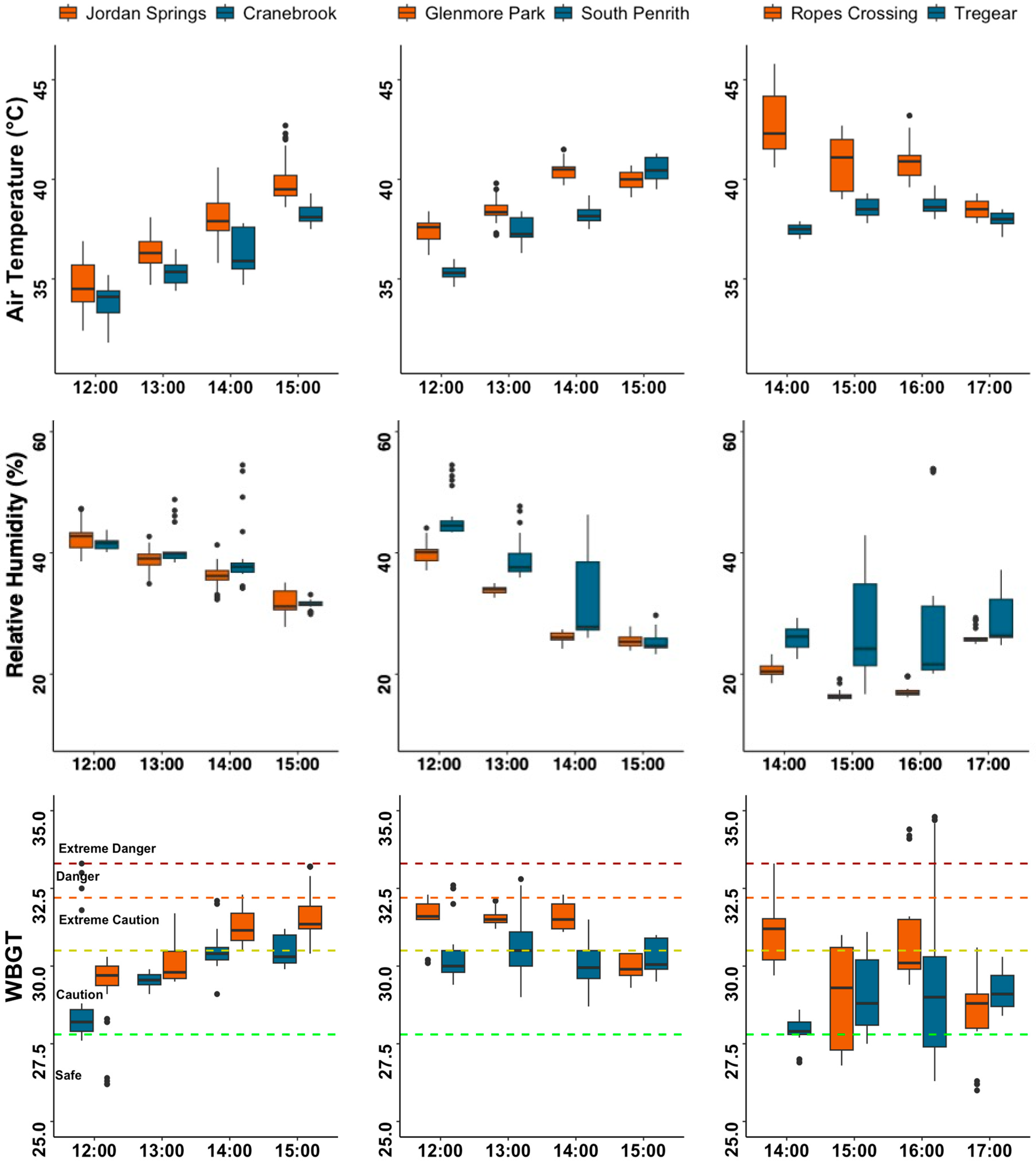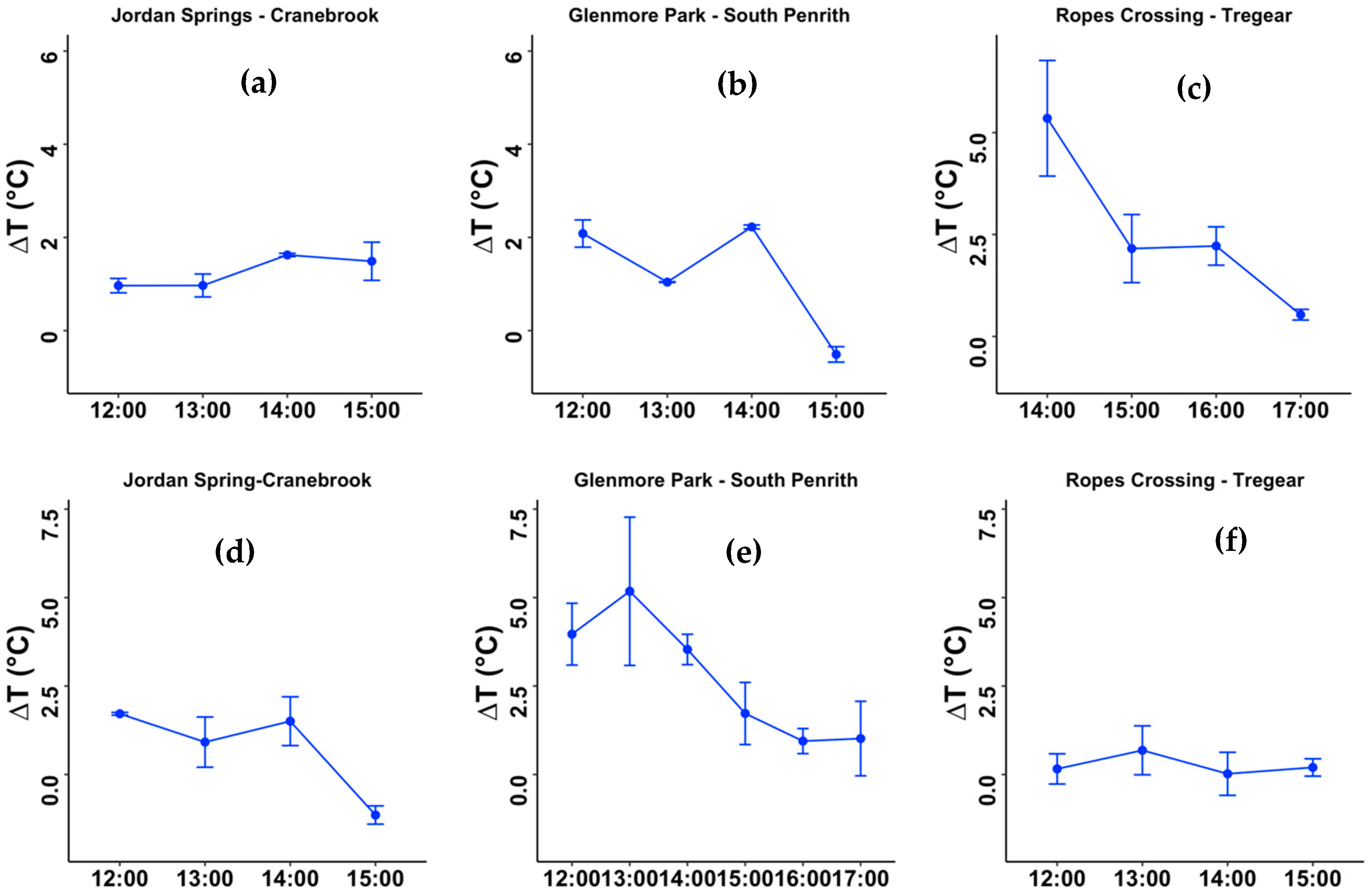Heat Impact of Urban Sprawl: How the Spatial Composition of Residential Suburbs Impacts Summer Air Temperatures and Thermal Comfort
Abstract
1. Introduction
2. Materials and Methods
2.1. Study Area
2.2. Data Collection
2.2.1. Micrometeorological Measurements
2.2.2. Tree Canopy Cover and Size of the Housing Lots
2.2.3. Thermal Comfort Measurement
2.3. Data Analysis
3. Results
4. Discussion
5. Limitations and Caveats
6. Conclusions
Author Contributions
Funding
Institutional Review Board Statement
Informed Consent Statement
Data Availability Statement
Conflicts of Interest
References
- Liu, Z.; Li, J.; Wu, Y.; Qin, C.; Liu, Y. Temporal Trend of the Frequency and Maximum Durations of Surface Urban Heat Islands over Global Cities. Nat. Cities 2024, 120, 106141. [Google Scholar] [CrossRef]
- Grant, L.; Vanderkelen, I.; Gudmundsson, L.; Fischer, E.; Seneviratne, S.I.; Thiery, W. Global Emergence of Unprecedented Lifetime Exposure to Climate Extremes. Nature 2025, 641, 374–379. [Google Scholar] [CrossRef] [PubMed]
- IPCC. Summary for Policymakers; Lee, H., Romero, J., Eds.; IPCC: Geneva, Switzerland, 2023; pp. 1–34. [Google Scholar]
- Coates, L.; van Leeuwen, J.; Browning, S.; Gissing, A.; Bratchell, J.; Avci, A. Heatwave Fatalities in Australia, 2001–2018: An Analysis of Coronial Records. Int. J. Disaster Risk Reduct. 2022, 67, 102671. [Google Scholar] [CrossRef]
- Perkins-Kirkpatrick, S.E.; White, C.J.; Alexander, L.V.; Argüeso, D.; Boschat, G.; Cowan, T.; Evans, J.P.; Ekström, M.; Oliver, E.C.J.; Phatak, A.; et al. Natural Hazards in Australia: Heatwaves. Clim. Change 2016, 139, 101–114. [Google Scholar] [CrossRef]
- Oke, T.R.; Mills, G.; Christen, A.; Voogt, J.A. Cities and Global Climate Change. In Urban Climates; Cambridge University Press: Cambridge, UK, 2017; pp. 360–384. [Google Scholar]
- Morabito, M.; Crisci, A.; Messeri, A.; Orlandini, S.; Raschi, A.; Maracchi, G.; Munafò, M. The Impact of Built-up Surfaces on Land Surface Temperatures in Italian Urban Areas. Sci. Total Environ. 2016, 551–552, 317–326. [Google Scholar] [CrossRef] [PubMed]
- Santamouris, M.; Haddad, S.; Fiorito, F.; Osmond, P.; Ding, L.; Prasad, D.; Wang, R. Urban Heat Island and Overheating Characteristics in Sydney, Australia. An Analysis of Multiyear Measurements. Sustainability 2017, 9, 712. [Google Scholar] [CrossRef]
- Huang, K.; Li, X.; Liu, X.; Seto, K.C. Projecting Global Urban Land Expansion and Heat Island Intensification through 2050. Environ. Res. Lett. 2019, 14, 114037. [Google Scholar] [CrossRef]
- United Nation 68% of the World Population Projected to Live in Urban Areas by 2050, Says UN. Available online: https://www.un.org/uk/desa/68-world-population-projected-live-urban-areas-2050-says-un (accessed on 20 January 2024).
- Rupp, R.F.; Vásquez, N.G.; Lamberts, R. A Review of Human Thermal Comfort in the Built Environment. Energy Build. 2015, 105, 178–205. [Google Scholar] [CrossRef]
- Jamei, E.; Rajagopalan, P. Urban Development and Pedestrian Thermal Comfort in Melbourne. Sol. Energy 2017, 1, 681–698. [Google Scholar] [CrossRef]
- Lai, D.; Liu, W.; Gan, T.; Liu, K.; Chen, Q. A Review of Mitigating Strategies to Improve the Thermal Environment and Thermal Comfort in Urban Outdoor Spaces. Sci. Total Environ. 2019, 661, 337–353. [Google Scholar] [CrossRef] [PubMed]
- Sharmin, M.; Tjoelker, M.G.; Pfautsch, S.; Esperón-Rodriguez, M.; Rymer, P.D.; Power, S.A. Tree Traits and Microclimatic Conditions Determine Cooling Benefits of Urban Trees. Atmosphere 2023, 14, 606. [Google Scholar] [CrossRef]
- Bowler, D.E.; Buyung-Ali, L.; Knight, T.M.; Pullin, A.S. Urban Greening to Cool Towns and Cities: A Systematic Review of the Empirical Evidence. Landsc. Urban Plan. 2010, 97, 147–155. [Google Scholar] [CrossRef]
- Johansson, E. Urban Thermal Comfort in the Tropics. In Urban Climate Challenges in the Tropics: Rethinking the Design Basis and Opportunities; Emmanuel, R., Ed.; Imperial College Press: London, UK, 2016; pp. 163–204. ISBN 9781783268405. [Google Scholar]
- Ng, E.; Cheng, V. Urban Human Thermal Comfort in Hot and Humid Hong Kong. Energy Build. 2012, 55, 51–65. [Google Scholar] [CrossRef]
- Wang, Y.; de Groot, R.; Bakker, F.; Wörtche, H.; Leemans, R. Thermal Comfort in Urban Green Spaces: A Survey on a Dutch University Campus. Int. J. Biometeorol. 2017, 61, 87–101. [Google Scholar] [CrossRef] [PubMed]
- Klemm, W.; Heusinkveld, B.G.; Lenzholzer, S.; van Hove, B. Street Greenery and Its Physical and Psychological Impact on Thermal Comfort. Landsc. Urban Plan. 2015, 138, 87–98. [Google Scholar] [CrossRef]
- Kong, F.; Yin, H.; James, P.; Hutyra, L.R.; He, H.S. Effects of Spatial Pattern of Greenspace on Urban Cooling in a Large Metropolitan Area of Eastern China. Landsc. Urban Plan. 2014, 128, 35–47. [Google Scholar] [CrossRef]
- Sharmin, M.; Tjoelker, M.G.; Pfautsch, S.; Esperon-Rodriguez, M.; Rymer, P.D.; Power, S.A. Tree Crown Traits and Planting Context Contribute to Reducing Urban Heat. Urban For. Urban Green. 2023, 83, 127913. [Google Scholar] [CrossRef]
- Gatto, E.; Buccolieri, R.; Aarrevaara, E.; Ippolito, F.; Emmanuel, R.; Perronace, L.; Santiago, J.L. Impact of Urban Vegetation on Outdoor Thermal Comfort: Comparison between a Mediterranean City (Lecce, Italy) and a Northern European City (Lahti, Finland). Forests 2020, 11, 228. [Google Scholar] [CrossRef]
- Mohajerani, A.; Bakaric, J.; Jeffrey-Bailey, T. The Urban Heat Island Effect, Its Causes, and Mitigation, with Reference to the Thermal Properties of Asphalt Concrete. J. Environ. Manag. 2017, 197, 522–538. [Google Scholar] [CrossRef] [PubMed]
- Hughes, L.H.E.F.J. The Silent Killer: Climate Change and the Health Impacts of Extreme Heat; Climate Council of Australia Limited: Sydney, NSW, Australia, 2016. [Google Scholar]
- Haynes, V.; Calgaro, E.; Dominey-Howes, D. The Future of Our Suburbs: Analyses of Heatwave Vulnerability in a Planned Estate. Geogr. Res. 2022, 60, 152–167. [Google Scholar] [CrossRef]
- Pfautsch, S.; Wujeska-Klause, A.; Walters, J.R. Spatiotemporal Variation of Intra-Urban Heat and Heatwaves across Greater Sydney, Australia. Weather Clim. Extrem. 2025, 47, 100741. [Google Scholar] [CrossRef]
- Cowan, T.; Purich, A.; Perkins, S.; Pezza, A.; Boschat, G.; Sadler, K. More Frequent, Longer, and Hotter Heat Waves for Australia in the Twenty-First Century. J. Clim. 2014, 27, 5851–5871. [Google Scholar] [CrossRef]
- CSIRO. Australia’s Changing Climate. 2024. Available online: https://www.csiro.au/en/research/environmental-impacts/climate-change/State-of-the-Climate/Australias-Changing-Climate (accessed on 10 April 2025).
- CSIRO. Bureau of Meteorology, State of the Climate. 2024. Available online: https://www.csiro.au/en/research/environmental-impacts/climate-change/State-of-the-Climate (accessed on 10 April 2025).
- Moallemi, M.; Melser, D. The Impact of Immigration on Housing Prices in Australia. Pap. Reg. Sci. 2020, 99, 773–786. [Google Scholar] [CrossRef]
- NSW Productivity Commission. Building More Homes Where Costs Less. Comparing the Marginal Costs of Servicing Growth in Different Areas of Sydney; NSW Productivity Commission: Sydney, NSW, Australia, 2023. [Google Scholar]
- NSW Government. A Metropolis of Three Cities: Great Open Space Places, Greater Housing Choice, Shorter Commutes and World Class Job Opportunities; NSW Government: Sydney, NSW, Australia, 2018. [Google Scholar]
- Uddin, F.K.; Piracha, A. Repeating History, Repeating Failure: A Study of the Sustainability-Related Urban Planning Policy Reforms in NSW, Australia. Aust. Plan. 2024, 60, 44–57. [Google Scholar] [CrossRef]
- Rouhollahi, M.; Behrend, M.; Boland, J. Optimising Tree Arrangement Policy in Australian Small-Scale Residential Settings. Sustain. Cities Soc. 2024, 102, 105232. [Google Scholar] [CrossRef]
- Australian Bureau of Statistics. New Houses Being Built on Smaller Blocks. Available online: https://www.abs.gov.au/articles/new-houses-being-built-smaller-blocks (accessed on 26 January 2024).
- Grimmond, S. Urbanization and Global Environmental Change: Local Effects of Urban Warming. Geogr. J. 2007, 173, 83–88. [Google Scholar] [CrossRef]
- Rahmani, N.; Sharifi, A. Urban Heat Dynamics in Local Climate Zones (LCZs): A Systematic Review. Build. Environ. 2025, 267, 112225. [Google Scholar] [CrossRef]
- Cat No. 1270.0.55.004; ASGA Australian Statistical Geography Standard. Volume 4—Significant Urban Areas, Urban Centres and Localities, Section of State. Australian Sign and Graphics Association: Epping, NSW, Australia, 2011.
- Australian Bureau of Statistics. Population Projections, Australia 2023. Available online: https://www.abs.gov.au/statistics/people/population/population-projections-australia/latest-release (accessed on 10 April 2025).
- Centre for Western Sydney. Western Sydney University Unveils Ambitious Economic Plan for the Region. Available online: https://www.westernsydney.edu.au/cws/media/western-sydneys-economic-plan (accessed on 18 March 2025).
- Penrith City Council. Resilient Penrith Action Plan: 2021–2030; Penrith City Council: Penrith, NSW, Australia, 2021. [Google Scholar]
- Khan, H.S.; Santamouris, M.; Kassomenos, P.; Paolini, R.; Caccetta, P.; Petrou, I. Spatiotemporal Variation in Urban Overheating Magnitude and Its Association with Synoptic Air-Masses in a Coastal City. Sci. Rep. 2021, 11, 6762. [Google Scholar] [CrossRef] [PubMed]
- Bureau of Meteorology New South Wales in January 2020. Available online: https://www.bom.gov.au/climate/current/month/nsw/archive/202001.summary.shtml (accessed on 10 May 2025).
- Ghorbankhani, Z.; Zarrabi, M.M.; Ghorbankhani, M. The Significance and Benefits of Green Infrastructures Using I-Tree Canopy Software with a Sustainable Approach. Environ. Dev. Sustain. 2024, 26, 14893–14913. [Google Scholar] [CrossRef]
- Jacobs, B.; Mikhailovich, N.; Delaney, C. Benchmarking Australia’s Urban Tree Canopy: An i-Tree Assessment; University of Technology Sydney: Ultimo, NSW, USA, 2014. [Google Scholar]
- Selim, S.; Dönmez, B.; Kilçik, A. Determination of the Optimum Number of Sample Points to Classify Land Cover Types and Estimate the Contribution of Trees on Ecosystem Services Using the I-Tree Canopy Tool. Integr. Environ. Assess. Manag. 2023, 19, 726–734. [Google Scholar] [CrossRef] [PubMed]
- Parmehr, E.G.; Amati, M.; Taylor, E.J.; Livesley, S.J. Estimation of Urban Tree Canopy Cover Using Random Point Sampling and Remote Sensing Methods. Urban For. Urban Green. 2016, 20, 160–171. [Google Scholar] [CrossRef]
- USDA. United States Department of Agriculture Forest Service, i-Tree Tools, i-Tree Canopy; USDA: Washington, DC, USA, 2021. [Google Scholar]
- Kamal, A.S.M.M.; Fahim, A.K.F.; Shahid, S. Changes in Wet Bulb Globe Temperature and Risk to Heat-Related Hazards in Bangladesh. Sci. Rep. 2024, 14, 10417. [Google Scholar] [CrossRef] [PubMed]
- Ohashi, Y.; Kawabe, T.; Shigeta, Y.; Hirano, Y.; Kusaka, H.; Fudeyasu, H.; Fukao, K. Evaluation of Urban Thermal Environments in Commercial and Residential Spaces in Okayama City, Japan, Using the Wet-Bulb Globe Temperature Index. Theor. Appl. Clim. 2009, 95, 279–289. [Google Scholar] [CrossRef]
- Carter, A.W.; Zaitchik, B.F.; Gohlke, J.M.; Wang, S.; Richardson, M.B. Methods for Estimating Wet Bulb Globe Temperature from Remote and Low-Cost Data: A Comparative Study in Central Alabama. Geohealth 2020, 4, e2019GH000231. [Google Scholar] [CrossRef] [PubMed]
- Yaglou, C.P.; Minard, D. Control of Heat Casualties at Military Training Centers. Arch. Ind. Health 1957, 16, 302–316. [Google Scholar]
- Department of the Army and Air Force. Heat Stress Control and Heat Casualty Management. Tech. Bull. Med. 2003, 507, 48–152. [Google Scholar]
- Havenith, G.; Fiala, D. Thermal Indices and Thermophysiological Modeling for Heat Stress. Compr. Physiol. 2016, 6, 1134. [Google Scholar] [CrossRef]
- Shin, J.Y.; Kim, K.R.; Ha, J.C. Intensity-Duration-Frequency Relationship of WBGT Extremes Using Regional Frequency Analysis in South Korea. Environ. Res. 2020, 190, 109964. [Google Scholar] [CrossRef] [PubMed]
- ISO 7726; Ergonomics of the Thermal Environment—Instruments for Measuring Physical Quantities. ISO: Geneva, Switzerland, 1998.
- Lam, C.K.C.; Gallant, A.J.E.; Tapper, N.J. Perceptions of Thermal Comfort in Heatwave and Non-Heatwave Conditions in Melbourne, Australia. Urban Clim. 2018, 23, 204–218. [Google Scholar] [CrossRef]
- Morabito, M.; Crisci, A.; Guerri, G.; Messeri, A.; Congedo, L.; Munafò, M. Surface Urban Heat Islands in Italian Metropolitan Cities: Tree Cover and Impervious Surface Influences. Sci. Total Environ. 2021, 751, 142334. [Google Scholar] [CrossRef] [PubMed]
- Shahfahad; Rihan, M.; Naikoo, M.W.; Ali, M.A.; Usmani, T.M.; Rahman, A. Urban Heat Island Dynamics in Response to Land-Use/Land-Cover Change in the Coastal City of Mumbai. J. Indian Soc. Remote Sens. 2021, 49, 2227–2247. [Google Scholar] [CrossRef]
- Sanaieian, H.; Tenpierik, M.; Van Den Linden, K.; Mehdizadeh Seraj, F.; Mofidi Shemrani, S.M. Review of the Impact of Urban Block Form on Thermal Performance, Solar Access and Ventilation. Renew. Sustain. Energy Rev. 2014, 38, 551–560. [Google Scholar] [CrossRef]
- Howe, D.A.; Hathaway, J.M.; Ellis, K.N.; Mason, L.R. Spatial and Temporal Variability of Air Temperature across Urban Neighborhoods with Varying Amounts of Tree Canopy. Urban For. Urban Green. 2017, 27, 109–116. [Google Scholar] [CrossRef]
- Khorat, S.; Das, D.; Khatun, R.; Aziz, S.M.; Anand, P.; Khan, A.; Santamouris, M.; Niyogi, D. Cool Roof Strategies for Urban Thermal Resilience to Extreme Heatwaves in Tropical Cities. Energy Build. 2024, 302, 113751. [Google Scholar] [CrossRef]
- Pfautsch, S.; Paolini, R. If You’ve Got a Dark Roof, You’re Spending Almost $700 Extra a Year to Keep Your House Cool. Available online: https://www.unsw.edu.au/newsroom/news/2024/03/dark-roof-spending-almost-700-extra-year-keep-house-cool (accessed on 2 May 2025).
- Santamouris, M.; Cartalis, C.; Synnefa, A.; Kolokotsa, D. On the Impact of Urban Heat Island and Global Warming on the Power Demand and Electricity Consumption of Buildings—A Review. Energy Build. 2015, 98, 119–124. [Google Scholar] [CrossRef]
- Erlwein, S.; Pauleit, S. Trade-Offs between Urban Green Space and Densification: Balancing Outdoor Thermal Comfort, Mobility, and Housing Demand. Urban Plan. 2021, 6, 5–19. [Google Scholar] [CrossRef]
- van Hove, L.W.A.; Jacobs, C.M.J.; Heusinkveld, B.G.; Elbers, J.A.; Van Driel, B.L.; Holtslag, A.A.M. Temporal and Spatial Variability of Urban Heat Island and Thermal Comfort within the Rotterdam Agglomeration. Build. Environ. 2015, 83, 91–103. [Google Scholar] [CrossRef]
- Grilo, F.; Pinho, P.; Aleixo, C.; Catita, C.; Silva, P.; Lopes, N.; Freitas, C.; Santos-Reis, M.; McPhearson, T.; Branquinho, C. Using Green to Cool the Grey: Modelling the Cooling Effect of Green Spaces with a High Spatial Resolution. Sci. Total Environ. 2020, 724, 138182. [Google Scholar] [CrossRef] [PubMed]
- Ren, Z.; Zhao, H.; Fu, Y.; Xiao, L.; Dong, Y. Effects of Urban Street Trees on Human Thermal Comfort and Physiological Indices: A Case Study in Changchun City, China. J. For. Res. 2022, 33, 911–922. [Google Scholar] [CrossRef]
- Qin, Y.; Liang, J.; Tan, K.; Li, F. A Side by Side Comparison of the Cooling Effect of Building Blocks with Retro-Reflective and Diffuse-Reflective Walls. Sol. Energy 2016, 133, 172–179. [Google Scholar] [CrossRef]
- Chen, X.; Jeong, S.; Zheng, Y.; Park, H.; Park, C.-E.; Joo, J.; Choi, W.; Chen, X.; Zheng, C. Evaluation of Different Roof Materials for the Mitigation of Urban Warming in a Subtropical Monsoon Climate. J. Geophys. Res. Atmos. 2020, 125, e2019JD031972. [Google Scholar] [CrossRef]
- Coutts, A.M.; Beringer, J.; Tapper, N.J. Impact of Increasing Urban Density on Local Climate: Spatial and Temporal Variations in the Surface Energy Balance in Melbourne, Australia. J. Appl. Meteorol. Clim. 2007, 46, 477–493. [Google Scholar] [CrossRef]
- Jacobs, S.J.; Gallant, A.J.E.; Tapper, N.J.; Li, D. Use of Cool Roofs and Vegetation to Mitigate Urban Heat and Improve Human Thermal Stress in Melbourne, Australia. J. Appl. Meteorol. Climatol. 2018, 57, 1747–1764. [Google Scholar] [CrossRef]
- Lam, C.K.C.; Loughnan, M.; Tapper, N. Visitors’ Perception of Thermal Comfort during Extreme Heat Events at the Royal Botanic Garden Melbourne. Int. J. Biometeorol. 2018, 62, 97–112. [Google Scholar] [CrossRef] [PubMed]
- Baccini, M.; Biggeri, A.; Accetta, G.; Kosatsky, T.; Katsouyanni, K.; Analitis, A.; Anderson, H.R.; Bisanti, L.; D’Iippoliti, D.; Danova, J.; et al. Heat Effects on Mortality in 15 European Cities. Epidemiology 2008, 19, 711–719. [Google Scholar] [CrossRef] [PubMed]
- De Troeyer, K.; Bauwelinck, M.; Aerts, R.; Profer, D.; Berckmans, J.; Delcloo, A.; Hamdi, R.; Van Schaeybroeck, B.; Hooyberghs, H.; Lauwaet, D.; et al. Heat Related Mortality in the Two Largest Belgian Urban Areas: A Time Series Analysis. Environ. Res. 2020, 188, 109848. [Google Scholar] [CrossRef] [PubMed]
- Mitchell, D.; Heaviside, C.; Vardoulakis, S.; Huntingford, C.; Masato, G.; Guillod, B.P.; Frumhoff, P.; Bowery, A.; Wallom, D.; Allen, M. Attributing Human Mortality during Extreme Heat Waves to Anthropogenic Climate Change. Environ. Res. Lett. 2016, 11, 074006. [Google Scholar] [CrossRef]
- Gill, S.E.; Handley, J.F.; Ennos, A.R.; Pauleit, S. Adapting Cities for Climate Change: The Role of the Green Infrastructure. Built Environ. 2007, 33, 115–133. [Google Scholar] [CrossRef]
- Ziter, C.D.; Pedersen, E.J.; Kucharik, C.J.; Turner, M.G. Scale-Dependent Interactions between Tree Canopy Cover and Impervious Surfaces Reduce Daytime Urban Heat during Summer. Proc. Natl. Acad. Sci. USA 2019, 116, 7575–7580. [Google Scholar] [CrossRef] [PubMed]
- Tamminga, K.; Cortesão, J.; Bakx, M. Convivial Greenstreets: A Concept for Climate-Responsive Urban Design. Sustainability 2020, 12, 3790. [Google Scholar] [CrossRef]
- Chitsa, M.; Sivapalan, S.; Singh, B.S.M.; Lee, K.E. Citizen Participation and Climate Change within an Urban Community Context: Insights for Policy Development for Bottom-Up Climate Action Engagement. Sustainability 2022, 14, 3701. [Google Scholar] [CrossRef]
- Özdamar, E.; Önay, E. An Overview of Transdisciplinary and Bottom-up Approach for Urban Resilience: The Case of Turkey. Environ. Sci. Sustain. Dev. 2024, 9, 1–16. [Google Scholar] [CrossRef]
- Kirkpatrick, J.B.; Daniels, G.D.; Davison, A. Temporal and Spatial Variation in Garden and Street Trees in Six Eastern Australian Cities. Landsc. Urban Plan. 2011, 101, 244–252. [Google Scholar] [CrossRef]
- Grifoni, R.C.; Passerini, G.; Pierantozzi, M. Assessment of Outdoor Thermal Comfort and Its Relation to Urban Geometry. WIT Trans. Ecol. Environ. 2013, 1, 3–14. [Google Scholar] [CrossRef]
- Aghamolaei, R.; Azizi, M.M.; Aminzadeh, B.; O’Donnell, J. A Comprehensive Review of Outdoor Thermal Comfort in Urban Areas: Effective Parameters and Approaches. Energy Environ. 2023, 34, 2204–2227. [Google Scholar] [CrossRef]
- Wang, Z.; de Dear, R.; Luo, M.; Lin, B.; He, Y.; Ghahramani, A.; Zhu, Y. Individual Difference in Thermal Comfort: A Literature Review. Build. Environ. 2018, 15, 181–193. [Google Scholar] [CrossRef]







| Residential Areas (Suburb, Postcode, LGA) | Construction Age | Area (km2) | Distance from the CBD (km) |
|---|---|---|---|
| Established suburbs | |||
| Cranebrook, 2749, City of Penrith | 1980 | 14.96 | 50 |
| South Penrith, 2750, City of Penrith | 1970 | 5.07 | 55 |
| Tregear, 2770, City of Blacktown | 1960 | 1.63 | 47 |
| Newly developed suburbs | |||
| Jordan Springs, 2747, City of Penrith | 2021 | 5.1 | 53 |
| Glenmore Park, 2745, City of Penrith | 2018 | 11.2 | 54 |
| Ropes Crossing, 2760, City of Blacktown | 2015 | 4.5 | 49 |
| Fieldwork Date | Residential Suburbs | Daily Max | Monthly Mean | |
|---|---|---|---|---|
| Heatwave (LGA) | Established | Newly Developed | Temp (°C) | Temp (°C) |
| 23 January 2021 (Penrith) | Cranebrook | Jordan Springs | 38.1 | 34.9 |
| 24 January 2021 (Penrith) | South Penrith | Glenmore Park | 39.9 | 34.9 |
| 25 January 2021 (Blacktown) | Tregear | Ropes Crossing | 40.0 | 34.9 |
| Non-heatwave (LGA) | ||||
| 4 March 2021 (Penrith) | South Penrith | Glenmore Park | 29.7 | 30.5 |
| 10 April 2021 (Blacktown) | Tregear | Ropes Crossing | 24.1 | 28.6 |
| 15 April 2021 (Penrith) | Cranebrook | Jordan Springs | 26.9 | 28.6 |
| Residential Areas | Roof Color | Mean Size of Housing Lots (m2) * | Most Abundant Tree Species |
|---|---|---|---|
| Established | |||
| Cranebrook | Light | 662.32 | Pyrus calleryana |
| South Penrith | Light | 623.92 | Liquidambar styraciflua Corymbia citriodora |
| Tregear | Light | 559.55 | Corymbia citriodora Eucalyptus microcarpa |
| Newly developed | |||
| Glenmore Park | Dark | 389.08 | Cupaniopsis anacardiodes |
| Jordan Springs | Dark | 380.76 | Melaleuca linariifolia Waterhousia floribunda |
| Ropes Crossing | Light and Dark | 327.38 | Waterhousia floribunda Tristaniopsis laurina |
| Heatwave Days/Suburbs | Area Type | Ta | RH | Wind Speed | WBGT |
| Mean ± SD (Range) | Mean ± SD (Range) | Mean ± SD (Range) | Mean ± SD (Range) | ||
| Jan 23 Jordan Springs | New | 37.27 ± 2.13 (32.4–42.7) | 37.18 ± 4.37 (27.8–47.3) | 0.87 ± 0.68 (0.0–3.6) | 30.63 ± 1.20 (26.20–33.2) |
| Jan 23 Cranebrook | Established | 35.75 ± 1.92 (31.8–39.3) | 40.07 ± 9.18 (29.9–80.6) | 0.72 ± 0.51 (0.0–2.0) | 29.75 ± 1.25 (27.6–33.3) |
| Jan 24 Glenmore Park | New | 38.35 ± 1.77 (34.6–41.5) | 33.93 ± 8.10 (23.2–62.5) | 0.82 ± 0.53 (0.0–2.2) | 30.71 ± 0.96 (28.70–32.8) |
| Jan 24 South Penrith | Established | 37.79 ±1.91 (34.6–41.3) | 35.82 ± 9.19 (23.2–62.5) | 0.79 ± 0.50 (0.0–2.1) | 30.33 ± 0.90 (28.7–32.8) |
| Jan 25 Tregear | New | 40.73 ±1.91 (37.8–45.8) | 20.00 ± 4.05 (15.6–29.3) | 0.85 ± 0.56 (0.0–2.7) | 29.86 ± 1.90 (26.0–34.4) |
| Jan 25 Ropes Crossing | Established | 38.21 ± 0.65 (37.0–39.7) | 27.35 ± 7.89 (16.7–53.9) | 0.68 ± 0.56 (0.0–2.7) | 28.94 ± 1.63 (26.3–34.8) |
| Non-heatwave days/Suburbs | |||||
| March 4 Glenmore Park | New | 31.50 ± 1.8 (26.9–35.7) | 35.89 ± 3.03 (29.1–44) | 0.58 ± 0.53 (0.0–2.3) | 25.80 ± 1.5 (24.2–31.4) |
| March 4 South Penrith | Established | 28.64 ± 2.36 (24.5–32.7) | 45.73 ± 13.58 (33.0–100) | 0.89 ±0.63 (0.0–2.9) | 23.58 ± 1.30 (19.6–27.8) |
| April 10 Ropes Crossing | New | 24.84 ± 1.11 (23.0–28.1) | 32.13 ± 2.06 (28.2–36.4) | 1.82 ± 0.80 (0.4–4.0) | 20.69 ± 0.92 (18.5–22.8) |
| April 10 Tregear | Established | 24.73 ± 0.81 (23.0–26.2) | 39.91 ± 11.70 (32.5–76.2) | 1.10 ± 0.60 (0.0–3.1) | 20.1 ± 1.26 (17.8–22.8) |
| April 15 Jordan Springs | New | 27.47 ± 1.46 (24.9–30.8) | 39.30 ± 13.54 (28.8–89.4) | 0.67 ± 0.52 (0.0–1.6) | 22.74 ± 1.30 (20.3–26.2) |
| April 15 Cranebrook | Established | 26.64 ± 1.16 (24.3–30.8) | 62.95 ± 25.63 (35.0–100) | 0.44 ± 0.51 (0.0–2.3) | 23.37 ± 2.93 (19.3–28.4) |
| Heatwave Days | Ta | RH | Wind Speed | Tmrt | WBGT |
| Jordan Springs/Cranebrook Jan 23 | 29.00 *** | 6.90 ** | 1.97 | 21.00 ** | 32.25 *** |
| (0.10) | (0.02) | (0.00) | (0.07) | (0.11) | |
| Glenmore Park/South Penrith Jan 24 | 19.84 *** | 11.82 ** | 0.96 | 23.79 *** | 34.78 *** |
| (0.10) | (0.06) | (0.12) | (0.18) | ||
| Ropes Crossing/Tregear Jan 25 | 96.39 *** | 64.33 *** | 4.01 | 21.89 *** | 20.60 *** |
| (0.48) | (0.32) | (0.02) | (0.10) | (0.10) | |
| Non-heatwave days | |||||
| Glenmore Park/South Penrith March 4 | 97.88 *** | 117.96 *** | 20.21 ** | 13.00 ** | 168.74 *** |
| (0.32) | (0.39) | (0.06) | (0.04) | (0.55) | |
| Ropes Crossing/Tregear April 10 | 0.04 | 89 *** | 43.20 ** | 124.88 *** | 50.91 *** |
| (0.00) | (0.45) | (0.22) | (0.63) | (0.26) | |
| Jordan Spring/Cranebrook April 15 | 10.28 *** | 94.47 *** | 11.04 * | 70.37 *** | 0.84 |
| (0.44) | (0.44) | (0.05) | (0.32) | (0.00) |
Disclaimer/Publisher’s Note: The statements, opinions and data contained in all publications are solely those of the individual author(s) and contributor(s) and not of MDPI and/or the editor(s). MDPI and/or the editor(s) disclaim responsibility for any injury to people or property resulting from any ideas, methods, instructions or products referred to in the content. |
© 2025 by the authors. Licensee MDPI, Basel, Switzerland. This article is an open access article distributed under the terms and conditions of the Creative Commons Attribution (CC BY) license (https://creativecommons.org/licenses/by/4.0/).
Share and Cite
Sharmin, M.; Esperon-Rodriguez, M.; Clackson, L.; Pfautsch, S.; Power, S.A. Heat Impact of Urban Sprawl: How the Spatial Composition of Residential Suburbs Impacts Summer Air Temperatures and Thermal Comfort. Atmosphere 2025, 16, 899. https://doi.org/10.3390/atmos16080899
Sharmin M, Esperon-Rodriguez M, Clackson L, Pfautsch S, Power SA. Heat Impact of Urban Sprawl: How the Spatial Composition of Residential Suburbs Impacts Summer Air Temperatures and Thermal Comfort. Atmosphere. 2025; 16(8):899. https://doi.org/10.3390/atmos16080899
Chicago/Turabian StyleSharmin, Mahmuda, Manuel Esperon-Rodriguez, Lauren Clackson, Sebastian Pfautsch, and Sally A. Power. 2025. "Heat Impact of Urban Sprawl: How the Spatial Composition of Residential Suburbs Impacts Summer Air Temperatures and Thermal Comfort" Atmosphere 16, no. 8: 899. https://doi.org/10.3390/atmos16080899
APA StyleSharmin, M., Esperon-Rodriguez, M., Clackson, L., Pfautsch, S., & Power, S. A. (2025). Heat Impact of Urban Sprawl: How the Spatial Composition of Residential Suburbs Impacts Summer Air Temperatures and Thermal Comfort. Atmosphere, 16(8), 899. https://doi.org/10.3390/atmos16080899








